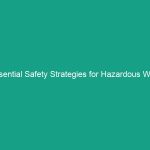Good Morning Team!
Today, we’re diving into a crucial aspect of our operations that directly influences our Safety and efficiency: Essential Crane Hand Signal Communication. Understanding and mastering these signals is vital for everyone involved in crane operations, whether you’re the operator or a ground crew member.
Effective communication is the backbone of a safe working Environment, especially when dealing with heavy machinery. Proper hand signals can prevent accidents and ensure that all team members are on the same page. Let’s explore why this topic is essential for our Workplace Safety.
Understanding Essential Crane Hand Signal Communication
So, what exactly is essential crane hand signal communication? In simple terms, it refers to the standardized signals used by operators and ground personnel to communicate during crane operations. These signals are crucial for coordinating movements and ensuring Safety on site.
Many may think that verbal communication is sufficient; however, the noise of machinery often makes this impractical. Hence, hand signals become indispensable. Miscommunication can lead to accidents, injuries, or even fatalities, which is why everyone must be well-versed in these signals.
Key Hazards, Risks, and Safety Considerations
Understanding the importance of hand signals is one thing, but recognizing the Hazards associated with poor communication is another. Here are some specific risks:
- Accidental Crane Movement: Without clear communication, crane operators may move the equipment when it is unsafe, potentially endangering workers.
- Misunderstood Signals: If signals are not standardized or clearly understood, it can result in incorrect crane movements.
- Injury Risks: Ground crew members may be in harm’s way if they are not aware of crane operations due to poor signaling.
The consequences of ignored safety protocols can be severe, leading to accidents that could have been easily avoided. Always remember: safety is everyone’s responsibility.
Best Practices, Procedures, & Actionable Advice
To ensure safety through effective communication, follow these Best Practices:
- Familiarize Yourself with Standard Signals: Everyone involved in crane operations should know the standard hand signals. Regular Training sessions can help reinforce this knowledge.
- Maintain Eye Contact: Always establish eye contact with the crane operator before signaling. This ensures that the operator is aware of your presence and ready to receive commands.
- Use Clear, Defined Signals: Make sure your hand signals are clear and distinct. Avoid any ambiguous gestures that could lead to confusion.
- Communicate Changes Promptly: If there are any changes in the Operation or if you are unsure about a signal, communicate this immediately.
Let’s look at a few common crane hand signals:
- Stop: Raise one arm horizontally with your palm facing the operator.
- Move Up: Raise one arm above your head, with your palm open and facing forward.
- Move Down: Lower your hand with your palm facing downwards.
Using real-world incidents can be beneficial for training. For instance, a construction site accident occurred due to unclear signals, resulting in an injury. This incident could have been avoided with proper training and adherence to hand signals.
Regulations, Standards, and Compliance
It’s crucial to understand that there are Regulations governing crane operations and hand signals. OSHA (Occupational Safety and Health Administration) has specific Standards that must be followed to ensure safety on job sites. Compliance with these regulations not only protects employees but also shields the company from legal liabilities.
Regular audits and training sessions should be conducted to ensure everyone is compliant with osha standards. Remember, safety is not just a guideline; it’s a requirement.
Employee Engagement & Discussion
Now, let’s open the floor for discussion. I want to hear from you:
- What safety challenges have you encountered related to crane operations?
- How can we improve our communication regarding crane hand signals?
Your insights are valuable, and sharing experiences can lead to better practices for all of us.
Conclusion & Key Takeaways
In conclusion, mastering essential crane hand signal communication is vital for our safety and operational efficiency. Remember to:
- Familiarize yourself with standard crane hand signals.
- Maintain clear communication at all times.
- Stay updated with OSHA regulations and ensure compliance.
Thank you all for your attention and for your commitment to making our workplace safer. Let’s prioritize safety, communicate effectively, and work together as a team!


